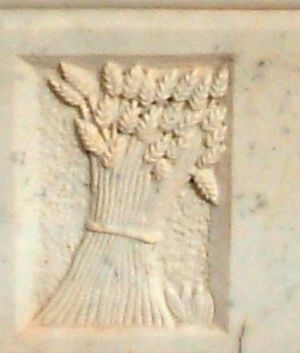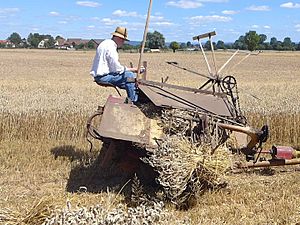Sheaf (agriculture) facts for kids
A sheaf is a bundle of cut grain stems. Farmers tie these stems together after harvesting. In the past, people used tools like sickles or scythes to cut the grain. Later, machines called reaper-binders helped to cut and tie the grain into sheaves.
How Sheaves Were Made
Before modern machines, farmers harvested grain by hand. They often worked in teams. They would cut a field of grain starting from the outside edge. As they cut, the grain stems would fall into a row.
After cutting, other workers would gather these stems. They would tie them into bundles using other cut stems. These bundles are what we call sheaves.
Drying and Storing Sheaves
Once tied, the sheaves needed to dry. Workers would stand them up in groups called stooks. A stook usually had three to eight sheaves. They were arranged like an "A" shape. This shape helped the air flow through the grain. It also kept the grain off the wet ground. This way, the grain could dry properly and stay safe from small animals.
After drying, the sheaves were moved. Farmers would use a special pitchfork to lift them onto a cart. This pitchfork had a long handle and two short prongs. The gathered sheaves were then taken to a barn. Sometimes, they were built into large stacks outside. These stacks could be very tall. The sheaves would dry more in the barn or stack. Later, the grain was separated from the stems in a process called threshing.
Sheaves Today
Over time, farming changed a lot. New machines like the combine harvester became common. These machines can cut, thresh, and clean grain all at once. Because of this, sheaves are not used as much in many countries. However, in places where harvesting is still done by hand, sheaves are still very important.
Sheaves in Symbols
In the world of heraldry, which is about coats of arms and symbols, a wheat sheaf has a special name. It is called a garb. You can often see a garb on old family crests or town symbols.
See also
 In Spanish: Gavilla para niños
In Spanish: Gavilla para niños
- Omer (unit), an old way to measure grain from the Bible.





